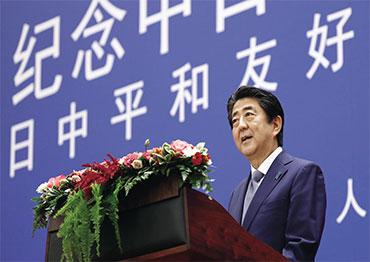But Abe’s reputation is not entirely negative in China. Some credit him with stabilizing Sino-Japanese relations amid the deteriorating relationship between China and the US.
When Abe assumed his second term as Japan’s prime minister in December 2012, China-Japan relations were at a low point: territorial disputes over the Diaoyu/Senkaku Islands in the East China Sea had rekindled after Japan “nationalized” the islands under the rule of the Democratic Party of Japan (DPJ) in September 2012.
During the Abe administration, Japan reached a “four-point consensus” on the issue with China in November 2014, with both sides agreeing to continue to develop a “mutually beneficial relationship.” A few days later, Abe visited Beijing to attend the 22nd APEC Economic Leaders’ Meeting and held his first summit meeting with Chinese President Xi Jinping.
During the Trump administration, Abe chose not to join Washington’s trade war against China. Instead, he visited China again in 2018, agreeing to explore the possibility of launching economic cooperation projects in third countries with China. Following Xi’s visit to Japan to attend the G20 Osaka Summit in 2019, Abe invited Xi to visit Japan again in 2020, though the plan was disrupted by the Covid-19 pandemic.
Under Abe’s iconic Abenomics policy, Japan turned to tourism for economic growth and substantially relaxed border entry requirements for Chinese tourists. With 9.6 million Chinese people visiting Japan in 2019, contributing 1.8 trillion yen (US$13.3b) to the Japanese economy, the move improved people-to-people communication between the two countries. Japan also joined the Regional Comprehensive Economic Partnership (RCEP) that went into effect this year, whose members include China, the 10 ASEAN countries, South Korea, Australia and New Zealand. In 2017, Abe even endorsed China’s Belt and Road Initiative (BRI), saying Japan is ready to “extend cooperation” with China on the BRI.
To many, the apparent paradox of Abe’s policies, both toward China and in other areas, made him a divisive and contradictory figure. But according to Zhang Yong, associate fellow with the Institute of Japanese Studies at the Chinese Academy of Social Sciences, coming from an elite political family and having waded through Japan’s complex clan politics, Abe was a master of the art of ambiguity and selfconcealment, values that are deeply rooted in Japan’s political culture. “He was both an idealist and a pragmatist,” Zhang said.
This may be best reflected in Abe’s handling of his relationship with former US president Donald Trump. Despite his concerns over Trump’s “America First” agenda that cast doubt on the value of Washington’s alliance with Tokyo, Abe hid any anguish he might have and strove to build a personal relationship with Trump, to the extent that he recommended Trump for the Nobel Peace Prize for wooing North Korean leader Kim Jong-un, which went against Abe’s own advice.
“Everything he did can be explained to serve Japan’s national interests,” Zhang said. “If you perceive his policies from this perspective, there is not much of a paradox.”
According to Hosoya Yuichi, a professor of international politics at Keio University in Tokyo, the apparent policy paradox reflects Abe’s efforts to strike a balance between the US and China.
“Abe had long been a representative of the more conservative faction within the LDP, which favors a tougher position against China,” Hosoya said. “But Abe fully understood that China is Japan’s top trade partner and plays a significant role in the region, and his top priority is Japan’s national interests.”
Abe also tried to balance the different factions within the LDP, Hosoya added. During his tenure, Nikai Toshihiro, dubbed the LDP’s most “pro-China” politician, became the party’s secretary general, and Kishida Fumio, Japan’s current prime minister who was widely considered a liberal, served as foreign minister in his cabinet.

 Old Version
Old Version



